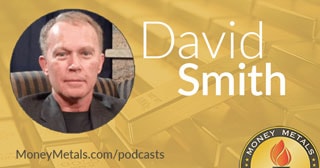Federal Reserve Cries Uncle as Rates Fall, Commodities Strengthen
by Mike Gleason, Money Metals:

Welcome to this week’s Market Wrap Podcast, I’m Mike Gleason.
Coming up David Smith, Senior Analyst at The Morgan Report and MoneyMetals.com columnist joins me and reviews the key reasons why we ought to own precious metals — and discusses the risks of NOT acting now when the price of silver is still cheap. He also discusses why he believes the set-up for the next bull leg higher in metals is going to be different than the false breakout we saw back in 2016. Don’t miss a fantastic interview with David Smith, coming up after this week’s market update.
Click HERE to listen
Well, as bulls and bears battle for control of the gold and silver markets, doves have gained full control of monetary policy at the Federal Reserve. On Wednesday, the Fed announced no change in interest rates – a decision which was expected. But policy makers went further and suggested there would be NO rate hikes at all for the REST of the year.
Bloomberg News Anchor: Doves fly, the pause continues, no change in the Fed’s target rate and they are done for the year. The Dot Plot now calls for no rate increase in 2019.
Supporting the change, big downward revisions to the economic outlook. The growth median is now 2.1% for this year, that’s down from 2.3% in their December forecast. Growth next year will be just 1.9%. The statement notes that the growth of economic activity has “slowed.”
So, if Jay Powell and company wanted to reassure investors the doves are in control here, it looks like they have done that.
The newly dovish Fed will also stop shrinking its balance sheet by the end of September. The Fed’s shift back into easy money mode reflects either a dramatic downgrade in the economic data or a craven capitulation to political pressure.
A case can be made that both the data and the politics helped push the Fed to completely abandon its former plans to continue gradually hiking rates this year. We can only speculate as to what words may have been exchanged between Federal Reserve Chairman Jerome Powell and the Donald Trump administration’s Plunge Protection Team late last year when markets were on the verge of crashing. But that period clearly served as an inflection point for monetary policy and the stock market.
Since then, stocks have surged higher. They rallied again following the Fed’s dovish pronouncements this week. In fact, virtually all asset classes got a boost from the Fed – stocks, bonds, commodities, and precious metals to some extent.
Gold prices currently check in at $1,311 per ounce, up 0.6% this week. Silver shows a weekly gain of 0.5% to bring spot prices to $15.43. Platinum is up 1.9% since last Friday’s close to trade at $851. And finally, palladium posted yet another record high this week. The supply constrained metal has pulled back a bit here the last couple of days and currently trades at $1,573 per ounce after advancing 0.8% on the week as of this Friday morning recording.
The move in gold and silver markets following the Fed’s announcement wasn’t as dramatic as bulls had hoped for. The money metals probably won’t accelerate to the upside in a big way until something breaks the uptrend in the S&P 500 and drives more safe-haven demand.
In the near term, momentum could take the major U.S. equity averages back up to test their old record highs. Around there, the markets could see some major technical resistance.
Investors will have to ask themselves whether they want to buy stocks trading near all-time highs when the economy is headed for a slowdown by the Fed’s own admission and the earnings picture is deteriorating.
Yes, a dovish Fed is supportive of higher equity prices – all else being equal. But that doesn’t necessarily mean equities will be the best performing asset class going forward.
Bonds caught a bid this week as interest rates fell and the yield curve flattened. Rates on Treasuries going out 10 years are now all close to 2.5%. There appears to be little room left for bonds to rally from here — unless the Fed starts cutting rates or investors are willing to accept lower yields on bonds than the short-term rate set by the Fed.
If the yield curve fully inverts and long-term paper yields less than short-term paper, that would represent an ominous sign for the economy. Historically, an inverted yield curve signals a coming recession.
On the other hand, commodity markets are coming back to life. Crude oil has been on fire of late, with West Texas Intermediate climbing above $60 per barrel this week as U.S. imports of Venezuelan oil shrank to zero for the first time in decades.
The plunge in oil prices in the fourth quarter of 2018 had contributed to disinflationary pressures. The Fed, in turn, lowered its inflation outlook. Central bankers now expect the inflation rate to trend slightly below their arbitrary 2% target over the next year. But if inflation pressures rise unexpectedly later this year, the Fed will be handcuffed by its own pronouncement to markets that it’s done raising rates.
While some investors are concerned about the risks of a slowing economy, virtually nobody on Wall Street is paying attention to the potential inflation threat. As a consequence, inflationary assets including energy stocks, mining stocks, and precious metals remain the most heavily discounted assets in an investment universe where good values, or even decent values, are hard to come by.
For the first time in years, U.S. monetary policy is now conducive to higher precious metals prices. The Fed isn’t the only factor that drives these markets, of course. But over time, being on the right side of the Fed usually leads to profitable outcomes.
Well now, without further delay, let’s get right to this week’s exclusive interview.

Mike Gleason: It is my privilege now to welcome back David Smith, Senior Analyst at The Morgan Report and regular contributor to MoneyMetals.com. David, it’s been too long. How are you my friend?
David Smith: It’s been a while and I’m happy to be back, Mike.
Mike Gleason: Well, David, for metals investors who got started after the 2008 financial crisis, it has not been an easy ride, as we both know. Prices rose sharply between 2008 and 2011, driven by the crisis and the Fed’s response to it, 0% interest rates and massive amounts of money creation. Then the metals markets began to flounder. Some of the safe haven demand for metals dried up as the equity markets recovered and fear dissipated. Price rigging and suppression in the futures markets has progressed from conspiracy theory to conspiracy fact. Metals prices are not being set in free or fair markets, so it is not easy for some investors to hang in there. But the reasons to own metal are still there, bigger than ever.
So, now might be a good time to review some of them. You talk a lot about precious metals role as insurance. Would you mind going over how metals act as a form of insurance for our listeners, David, as we start out today?
David Smith: Well, there’s several iterations of the insurance piece. As David Morgan of The Morgan Report always talks about, you buy the physical first and you buy that for insurance first and profits second. But if you look back, and a lot of people would not even believe this until they saw the chart. But gold held since 2000, has doubled the appreciation of the stock market, the overall stock market.
So, in spite of the big plans that we’ve seen, that we saw from $1,900 down to about $1,050 and then the move in 2016, we had, which gave most of it back and gold ended up for the whole process from that point, down about 45%. Silver down about 70% from 2011. In spite of that, the metals are still using their role as insurance of helping you diversify, of helping contradict other price changes in investments you may have and then, providing liquidity for you. So they, historically, have done that very well, that role of insurance and they continue to do so.
Loading...



